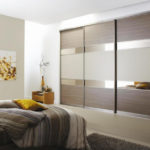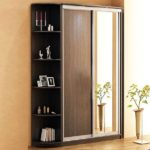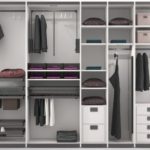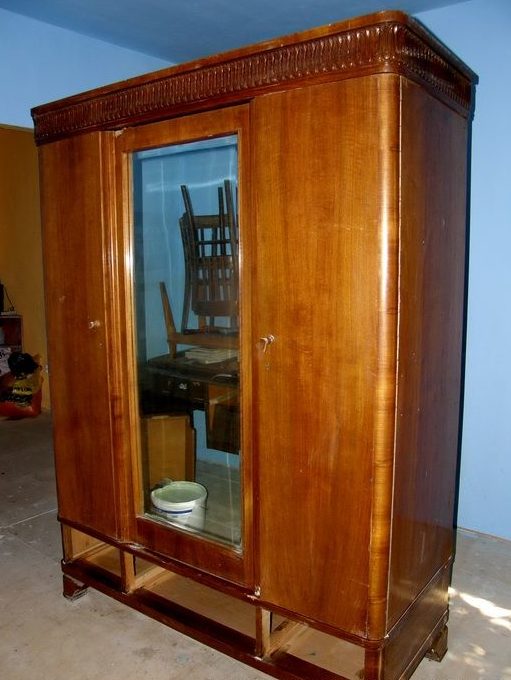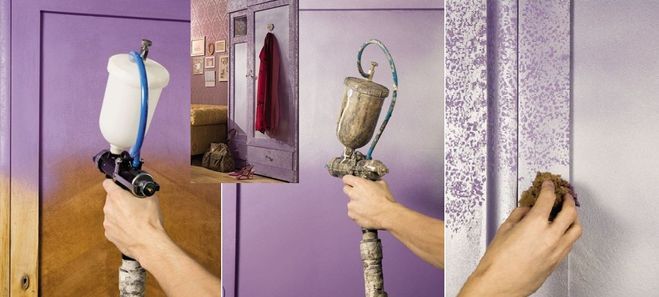Filling the bedroom closet
Filling your bedroom closets needs to be planned carefully. Since, in addition to everyday clothes, it can contain various accessories that are not used constantly, bedding sets, shoes, holiday items and various small accessories, such as ties, belts. In general, there is something to think about.
The content of the article
Options for filling wardrobes in the bedroom
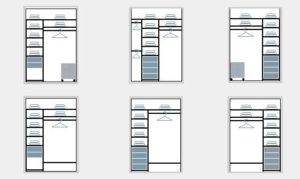 The wardrobe in the bedroom, the internal contents and photos of which will be presented below, has fittings thought out to the smallest detail. This ensures its functionality, convenience, space saving, and comfort for residents. There are no generally accepted solutions for filling, however, there are a number of recommendations for the rational organization of space that owners should heed:
The wardrobe in the bedroom, the internal contents and photos of which will be presented below, has fittings thought out to the smallest detail. This ensures its functionality, convenience, space saving, and comfort for residents. There are no generally accepted solutions for filling, however, there are a number of recommendations for the rational organization of space that owners should heed:
- Decide what exactly they want to keep in the bedroom. These will be bedding sets, towels and casual clothing, or children's clothing and accessories, wardrobe items and shoes not used daily, etc. will be stored there.
- Consider how they are going to store these things: folded on shelves or hung on hangers, in hanging drawers, or using special structures.
- Understand whether they want to separate zones, for example, separately for men and women, or whether this is not important.
There are a huge number of options, but a built-in wardrobe, corner or radius is definitely suitable for the bedroom. Next, we will consider the options for their configuration.
Filling a corner cabinet
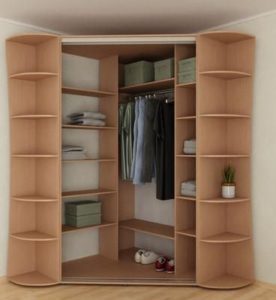 A corner wardrobe is suitable for a bedroom if you plan to place a lot of different clothes, things, and household items in it. A special feature of this design is the angle, often called the “dead zone”. The space in the corner will be maximally used if you place things there that need to be taken out infrequently. This area can also be optimized due to the built-in rotating racks.
A corner wardrobe is suitable for a bedroom if you plan to place a lot of different clothes, things, and household items in it. A special feature of this design is the angle, often called the “dead zone”. The space in the corner will be maximally used if you place things there that need to be taken out infrequently. This area can also be optimized due to the built-in rotating racks.
Filling the built-in wardrobe
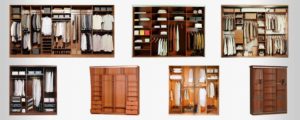 The design of the built-in wardrobe is mounted in a niche of the room or along one of the walls. This option is interesting because the side and rear panels are the walls of the room. Only the facade with doors is installed. There are from 2 to 4 doors and even more. You can fill the built-in closet with various elements and components.
The design of the built-in wardrobe is mounted in a niche of the room or along one of the walls. This option is interesting because the side and rear panels are the walls of the room. Only the facade with doors is installed. There are from 2 to 4 doors and even more. You can fill the built-in closet with various elements and components.
Filling the radius cabinet
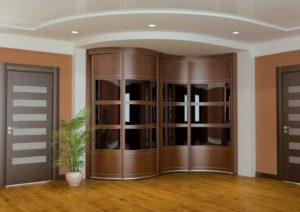 A corner wardrobe for a bedroom, the internal contents of which can be different, can have an interesting design. The shape of the doors of radius furniture is curvilinear, and accordingly the internal structure is unusual. In the corner there may be vertical rods or structures with a rotating mechanism. To maximize the use of the entire space, pantographs of various types are well suited.
A corner wardrobe for a bedroom, the internal contents of which can be different, can have an interesting design. The shape of the doors of radius furniture is curvilinear, and accordingly the internal structure is unusual. In the corner there may be vertical rods or structures with a rotating mechanism. To maximize the use of the entire space, pantographs of various types are well suited.
What elements are required to be filled out?
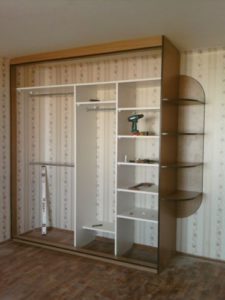 Since the bedroom requires storage of bedding sets and clothes, most of the closet is occupied by spacious shelves.
Since the bedroom requires storage of bedding sets and clothes, most of the closet is occupied by spacious shelves.
Shelves come in different parameters, but their recommended height is thirty centimeters. Stacks of several things will fit there.The width of the shelves is determined by the width of the doors for maximum accessibility to things.
It’s hard to imagine a bedroom closet without drawers. They are used for sets of underwear, socks and other small wardrobe items. It is important only when planning them to choose high-quality guiding mechanisms. They should slide out and slide back in easily. Closing mechanisms that provide independent soft closure have proven themselves well. If there are young children in the family, drawer locking devices will also come in handy.
The design of the handles is also important. Experts recommend using models of “hidden” handles; they are practical and do not block the movement of doors along the guides.
Hangers are also a common element of any closet. At least two rods are installed at different heights. One corresponds to the length of coats and dresses, and the other is used for shirts and blouses.
Filling a corner wardrobe in a bedroom with rods placed parallel to the doors has many advantages. They provide good visibility, however, this option is suitable for structures with a depth of 60 centimeters. If the cabinet is shallow, then the ideal solution is a rod with a perpendicular retractable mount.
The above listed elements refer to the standard contents of the wardrobe. But it can also have various special fittings, both budget and premium.
A wardrobe in a bedroom, the internal content of which can be different, is often equipped with pantographs. Thanks to them, getting things out becomes much more convenient. The pantograph is a U-shaped structure made of durable metal.It is placed at the very top and can be easily lowered by moving a special handle. Pantographs are made in different sizes, but are selected in accordance with the width of the cabinet compartments.
Another interesting solution is a curved hanger, with clothes hooks placed at a certain distance and at different angles.
Practical elements include special devices for trousers, skirts, belts and ties, and original shelves for shoes. They provide compact and neat placement of specific items.
The most common type of “shoe rack” is shelves made of metal mesh, secured at an angle with brackets. Shoe rack holders are attached to the inner intermediate wall of the cabinet.
The interior of the wardrobe in the bedroom may have hangers. A trouser hanger or so-called “trouser hanger” is ideal for a wardrobe, it can be easily pulled out and takes up minimal space. It is a retractable rod on ball guides. Allows you to compactly store many pairs of trousers, very convenient for frequent use.
Tie devices can also take the form of a bar with hooks or loops. They differ in the number of hooks. They are placed on the side panels and take up minimal space. In addition, you can define a drawer for ties, and small square sections can be constructed inside with partitions.
A built-in wardrobe in a bedroom, the filling options for which can be different, can have a very non-standard design. For example, inside you can place: a TV, a small table with a computer, a ladies' dressing table, a retractable ironing board.In particular, there are even several possible options for the TV: you can hang it on one of the doors or on the back wall behind the sliding doors, or leave one of the compartments without a door. It is clear that such a model will cost more than a regular one.
Cabinet zoning rules
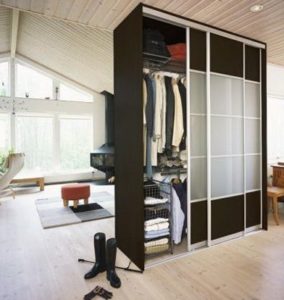 A good solution when making a cabinet would be to use the zoning technique. This technique involves dividing the space into three zones:
A good solution when making a cabinet would be to use the zoning technique. This technique involves dividing the space into three zones:
- The upper level can be spacious shelves or mezzanines, where large things that are used less often will be placed. For example, warm blankets or rugs for guests, hats. It’s also convenient to store suitcases and hiking backpacks;
- The middle level is an area for casual clothing, and accordingly assumes the presence of shelves and rods of various heights for shirts, dresses, trousers, etc. This area needs to be carefully thought out: the height of the rods should correspond to the height of the residents, so that they do not have to stretch or bend over too much. Clothing should not wrinkle or interfere with or catch other clothing when removed and stored. Underwear drawers must also be placed here;
- The lower level is reserved for boxes with shoes or “shoe racks”, as well as boxes with small items.
If you follow the zoning rules, you will get a spacious and easy-to-use sliding wardrobe.
A bedroom is a place intended for sleep and relaxation; nothing should disturb or irritate the owners. To create comfort, preference is given to minimalism: only the necessary furniture and no unnecessary clothes or things on the headboard, bedside tables or chest of drawers.

